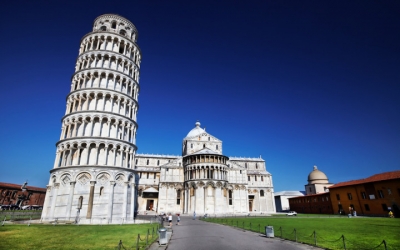
1. Took nearly two centuries to build
The Leaning Tower of Pisa was designed to be a bell tower for the Pisa Cathedral. Construction of the tower started in 1173. Workers had almost completed the third storey of the tower by 1178, when war broke out between Italian states. The war halted the construction for nearly a century, and work resumed in 1272. Again after 12 years, another war halted construction. Finally, the third stage of the construction began in the early 14th Century and concluded with the installation of the bell chamber in 1372.
2. The lean is accidental
The Leaning Tower of Pisa was never supposed to lean. It happened accidentally. The reason the tower began to lean is attributed to its weak foundation and the inexperience of the engineers. The tower began to sink when the second floor was being constructed. This was due to a three-metre foundation set in weak, unstable subsoil. The tower would have toppled over as construction progressed, however, the gap of nearly a century owing to the war helped the underlying soil to settle. To compensate for the tilt, engineers built the upper floors with one side taller than the other. Because of this, the tower is curved.
3. Status: Currently stable
The tower continued to tilt nearly 0.05 inches per year, placing the monument in danger of an imminent collapse. By 1990s, the tilt of the tower was almost 5.5 degrees (15 feet) from the perpendicular. This led the government to take urgent measures to protect the monument. The tower was closed to the public and a team of engineers levelled the soil underneath the tower. Engineers also used anchoring mechanisms to rectify its lean. While this helped the monument stabilise, it did not prevent its continued lean. In 2008, engineers again tried to balance the foundational soil and for the first time since it was constructed, the continued tilt of the tower halted. Engineers stated that the tower would be stable for at least the next 200 years.
4. No bells tolling
The Leaning Tower of Pisa has seven giant bells at the top, one for each musical note from the major scale. While the bells are still around, they haven’t tolled since the 20th century. This is because restorers and engineers were worried that their movements might make the tower lean more.
5. Not the only leaning tower in Pisa
As a result of Pisa’s soft soil, the Leaning Tower of Pisa isn’t the only building in the city that leans. The most popular building after the Leaning Tower of Pisa is the Bell Tower of the San Nicola church. Built around the same time as the Leaning Tower, this octangular bell tower also has a slight, but unmistakable tilt. Another popular building is the San Michele degli Scalzi, a 11th Century church, which tilts even more than the Leaning Tower of Pisa!
Picture Credit : Google




